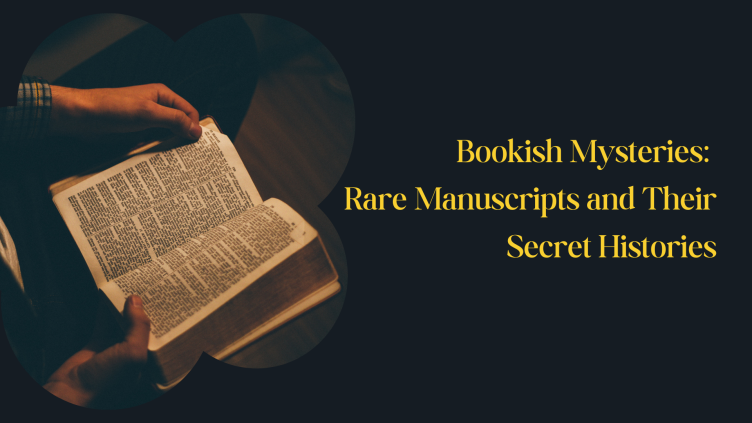Welcome to another intriguing exploration here at Riya’s Blogs, where we delve into the fascinating world of literature and history. Today, we’re uncovering the hidden stories behind rare manuscripts and their secret histories. If you’ve ever been captivated by the allure of ancient texts and the mysteries they hold, you’re in for a treat. Let’s embark on a journey through time and uncover the secrets of some of the world’s most enigmatic and valuable manuscripts.
The Allure of Rare Manuscripts
Rare manuscripts have an almost magical quality to them. They’re not just old books; they’re treasures that hold within them the whispers of history, the echoes of past civilizations, and the secrets of long-forgotten worlds. From medieval manuscripts adorned with intricate illuminations to handwritten notes by literary legends, these documents are more than just relics—they’re gateways to the past.
Why are rare manuscripts so captivating? It’s partly their scarcity. With only a few surviving copies, each manuscript is a unique snapshot of a specific time and place. Additionally, the craftsmanship involved in creating these documents adds to their allure. The painstaking process of writing by hand, illuminating with gold leaf, and binding with care all contribute to their status as priceless artifacts.
Unveiling the Mysteries
The Voynich Manuscript: The Enigma of the Unknown
One of the most famous and baffling manuscripts is the Voynich Manuscript. Discovered in 1912 by rare book dealer Wilfrid Voynich, this document is written in an unknown script and features bizarre illustrations of plants, astronomical charts, and human figures. Despite numerous attempts by cryptographers and historians to decode its contents, the Voynich Manuscript remains a mystery.
Experts speculate that the manuscript may be an elaborate hoax, a lost language, or a genuine cryptic document. However, its origins and purpose continue to elude scholars, making it one of the most intriguing mysteries in the world of rare manuscripts.
The Gutenberg Bible: The Dawn of Printing
Another significant manuscript is the Gutenberg Bible, also known as the 42-line Bible. Printed by Johannes Gutenberg in the 15th century, this work is notable for being one of the first major books printed using movable type. It marked a revolutionary moment in the history of printing and has since become a symbol of the spread of knowledge.
The Gutenberg Bible is not just a historical artifact; it’s a testament to the power of innovation and its impact on society. Each surviving copy of this book is a valuable piece of history, representing the beginning of the modern era of printing and publishing.
Shakespeare’s First Folio: The Birth of the Bard’s Legacy
William Shakespeare’s works are some of the most celebrated in literary history. The First Folio, published in 1623, is a collection of Shakespeare’s plays and is crucial to our understanding of his work. Without this folio, many of Shakespeare’s plays might have been lost to time.
The First Folio is a treasure trove for scholars and enthusiasts alike. It contains 36 plays, including classics like “Hamlet,” “Macbeth,” and “The Tempest.” The manuscript’s historical significance cannot be overstated, as it provides the foundation for the study and appreciation of Shakespeare’s oeuvre.
Hidden Histories and Secret Lives
Rare manuscripts often come with hidden histories and secret lives of their own. Here are a few more examples of manuscripts that have intriguing backstories:
- The Codex Leicester: Written by Leonardo da Vinci, this manuscript contains scientific writings and sketches. It offers a glimpse into da Vinci’s mind and his thoughts on water, astronomy, and geology. The Codex Leicester’s secrets are revealed through its detailed observations and innovative ideas.
- The Book of Kells: An illuminated manuscript created by Celtic monks around the 9th century, the Book of Kells is renowned for its elaborate artwork and intricate designs. The manuscript is a masterpiece of medieval art and is considered one of Ireland’s greatest cultural treasures.
- The Nag Hammadi Library: Discovered in Egypt in 1945, this collection of early Christian and Gnostic texts provides valuable insights into early religious beliefs and practices. The manuscripts are crucial for understanding the diversity of early Christianity and the development of religious thought.
The Modern Quest for Manuscripts
In the digital age, the quest for rare manuscripts continues, but it has taken on new dimensions. Researchers, collectors, and institutions are using advanced technology to discover, preserve, and study these invaluable texts. Digital imaging, for example, allows scholars to examine manuscripts in unprecedented detail, revealing hidden features and making them accessible to a global audience.
Preserving the Past for the Future
The preservation of rare manuscripts is a delicate and essential task. Institutions like the British Library, the Library of Congress, and the Bodleian Library are at the forefront of conservation efforts, ensuring that these priceless documents remain intact for future generations. Techniques such as climate control, careful handling, and digitization are employed to protect these manuscripts from deterioration and damage.
Conclusion
Rare manuscripts are not just old books; they are treasures that offer a window into the past. Each manuscript carries with it a story, a history, and a mystery waiting to be unraveled. Whether it’s the enigmatic Voynich Manuscript, the groundbreaking Gutenberg Bible, or Shakespeare’s First Folio, these documents continue to fascinate and inspire.
At Riya’s Blogs, we’re passionate about exploring these literary wonders and sharing their stories with you. We hope this journey through the world of rare manuscripts has ignited your curiosity and deepened your appreciation for these remarkable artifacts.
For more engaging content on literature, history, and the mysteries of the written word, visit Riya’s Blogs. Stay tuned for more captivating articles that delve into the magic of books and the secrets they hold.
Happy reading!







